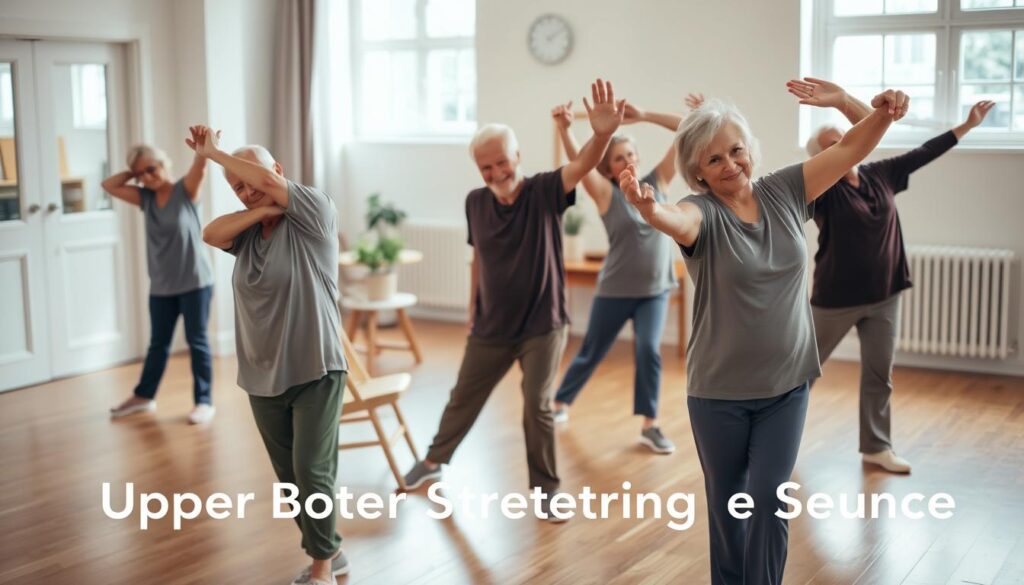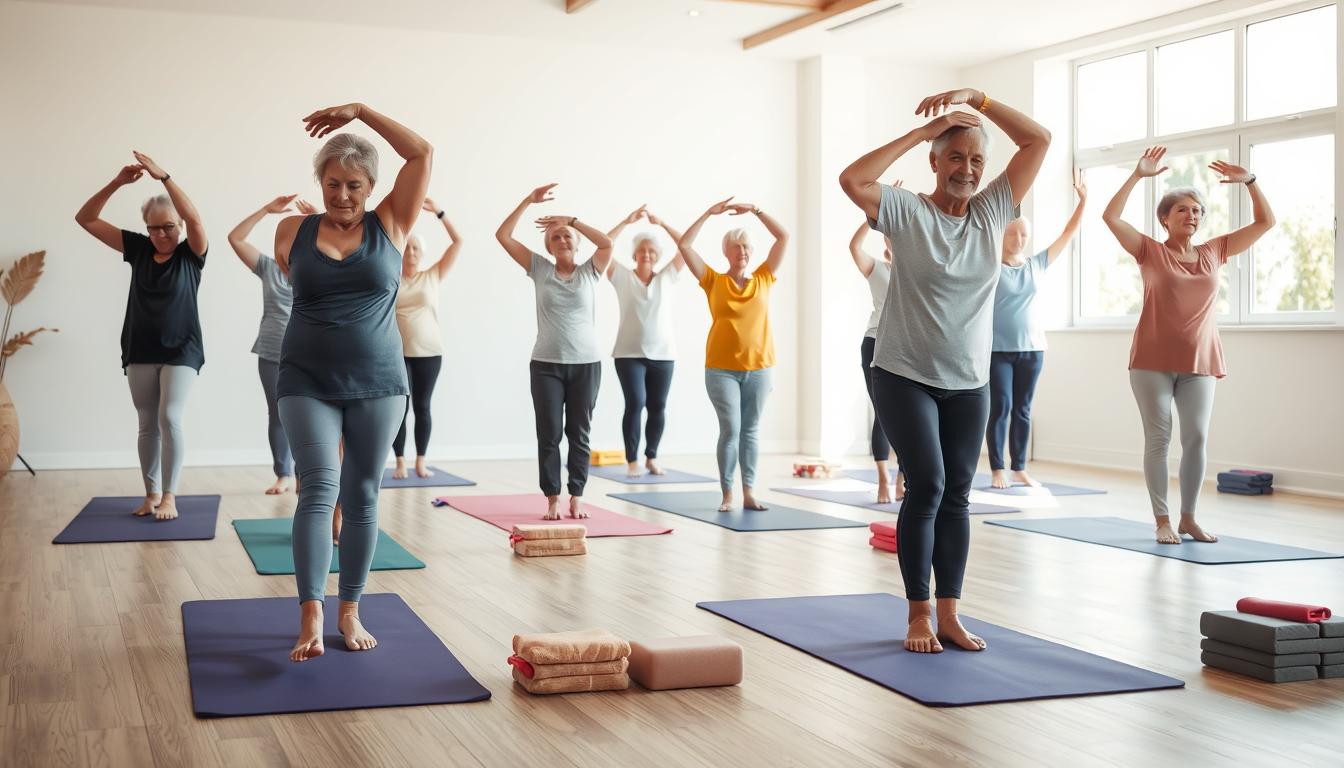As people age, maintaining joint flexibility becomes increasingly important for overall health and mobility. After 50, the body’s natural flexibility can decrease due to various factors, including reduced physical activity and age-related changes in the joints.
A consistent stretching routine can significantly improve and maintain flexibility, enhancing the quality of life. Regular stretching exercises can help reduce stiffness, improve range of motion, and support independence in daily activities.
By incorporating simple stretching exercises into your daily routine, you can take a proactive approach to maintaining your joint health. This article will guide you through the benefits and provide a comprehensive daily stretching routine tailored for individuals over 50.
Key Takeaways
- Regular stretching can improve joint flexibility and reduce stiffness.
- A daily stretching routine supports independence in daily activities.
- Simple stretching exercises can be adapted for individuals over 50.
- Consistency is key to maintaining flexibility through stretching.
- Stretching exercises can enhance overall quality of life.
Understanding Joint Flexibility Changes After50
Maintaining joint flexibility is essential for mobility and quality of life, particularly after the age of 50. As we age, our joints undergo natural changes that can affect flexibility and mobility. Understanding these changes is crucial for developing an effective daily joint mobility routine.
Natural Age-Related Changes in Joints and Muscles
Aging leads to various changes in the joints and muscles, including decreased production of synovial fluid, which lubricates the joints, and a reduction in muscle mass and strength. These changes can result in stiffness and reduced flexibility. Regular movement and stretching can help mitigate some of these effects.
Some key age-related changes include:
- Reduced collagen production, affecting tendon and ligament elasticity
- Increased stiffness due to decreased synovial fluid
- Loss of muscle mass (sarcopenia)
Benefits of Regular Stretching for Older Adults
Engaging in a regular over50 stretching program can significantly improve flexibility and mobility. Stretching helps maintain or even improve range of motion, reduces stiffness, and can enhance overall physical function.
The benefits of flexibility exercises for older adults include:
- Improved balance and reduced risk of falls
- Enhanced mobility and ability to perform daily activities
- Reduced muscle soreness and improved recovery after exercise
By incorporating stretching into their daily routine, older adults can maintain independence and enjoy a better quality of life.
Preparing for Your Daily Stretching Routine for Joint Flexibility Over50
A well-prepared stretching routine can make all the difference in improving joint flexibility for individuals over 50. Before starting any new exercise regimen, it’s essential to lay the groundwork for a safe and effective practice.
Creating a Safe Stretching Environment
To begin, create a safe stretching environment by clearing a spacious area free from obstacles. Ensure the floor is non-slippery and consider using a yoga mat for better grip and comfort. Good lighting is also crucial, so the area is well-lit to prevent accidents.
Essential Equipment and Props
While not necessary, certain equipment and props can enhance your stretching routine. A yoga mat, resistance bands, or a foam roller can be useful tools. Consider using a chair or wall for support if you have balance issues.
| Equipment | Benefits |
|---|---|
| Yoga Mat | Provides grip and cushioning |
| Resistance Bands | Assists in deepening stretches |
| Foam Roller | Helps in muscle recovery |
Best Times of Day to Stretch
The best time to stretch can vary depending on your schedule and personal preference. Many find that stretching in the morning helps increase blood flow and energy levels throughout the day. Others prefer stretching in the evening as a way to unwind.
“Stretching is not just about flexibility; it’s about taking care of your body and enhancing your overall well-being.”
For a daily joint stretching regimen, consistency is key. Choose a time that fits your routine and stick to it.
Warm-Up Exercises Before Stretching
Warming up is a vital precursor to any stretching routine, especially for individuals over 50 looking to improve joint flexibility. A proper warm-up prepares the muscles and joints for more intense stretching, reducing the risk of injury and enhancing the effectiveness of the routine.
Gentle Cardiovascular Activities
Gentle cardiovascular activities are an excellent way to begin a warm-up routine. These can include brisk walking, light jogging, or cycling at a leisurely pace. Such activities increase blood flow to the muscles, warm up the joints, and prepare the cardiovascular system for more strenuous exercise. For older adults, it’s essential to start slowly and gradually increase the intensity to avoid putting excessive strain on the joints.
Examples of gentle cardiovascular activities include swimming, dancing, or using a stationary bike. These exercises are low-impact and can be modified to suit different fitness levels, making them ideal for seniors.
Dynamic Movement Preparation
Dynamic movement preparation involves active movements that prepare the muscles and joints for stretching. This can include leg swings, arm circles, and hip rotations. Dynamic movements help improve flexibility and range of motion, making the subsequent stretching exercises more effective.
It’s crucial to perform these movements in a controlled manner, avoiding any jerky or bouncy actions that could cause injury. By incorporating dynamic movement preparation into the warm-up routine, older adults can enhance their joint flexibility and overall mobility.
Upper Body Stretching Sequence
Improving upper body flexibility through stretching can make a significant difference in the quality of daily life for seniors. A well-structured stretching routine can help maintain or even improve range of motion, reduce stiffness, and enhance overall mobility.
Neck and Shoulder Mobility Exercises
Neck and shoulder mobility exercises are crucial for reducing tension and improving flexibility. Start with simple neck stretches: slowly tilt your head to the side, bringing your ear towards your shoulder, and then return to the center. Repeat on the other side. For shoulder mobility, roll your shoulders forward and backward in a circular motion.
- Chin Tucks: Stand or sit with good posture and tuck your chin in towards your chest.
- Shoulder Rolls: Roll your shoulders forward and backward.
Arm and Wrist Flexibility Movements
Arm and wrist flexibility movements can help improve dexterity and reduce stiffness. Begin with arm circles, holding your arms straight out to the sides and making small circles with your hands.
- Wrist Extensions: Hold your arm straight out in front of you and gently pull your wrist back with your other hand.
- Arm Circles: Hold your arms straight out to the sides and make small circles.

Upper Back and Chest Stretches
Upper back and chest stretches can help counteract the forward leaning posture that many seniors adopt. Try a chest stretch by standing in a doorway with your hands on the doorframe at shoulder height.
- Chest Stretch: Stand in a doorway with your hands on the doorframe.
- Upper Back Stretch: Place your hands behind your back and gently arch backward.
By incorporating these upper body stretching exercises into your daily routine, you can improve your flexibility, reduce muscle tension, and enhance your overall quality of life.
Lower Body Stretching Routine
Lower body stretching is essential for older adults to enhance flexibility and reduce the risk of falls. As people age, their joints and muscles undergo natural changes that can affect mobility and balance. A well-structured daily stretching routine can help mitigate these effects.
Hip and Glute Flexibility Exercises
Stretching the hips and glutes is crucial for maintaining mobility and preventing stiffness. Exercises such as the standing hip flexor stretch and the seated glute stretch can be particularly beneficial. These stretches help improve flexibility and reduce the risk of discomfort or injury.
To perform a standing hip flexor stretch, stand with one hand against a wall for balance, take a large step forward with one foot, and lower your body until you feel a stretch in the front of your hip. Hold for 30 seconds and switch legs.
Knee and Ankle Mobility Movements
Knee and ankle mobility are vital for everyday activities such as walking and climbing stairs. Simple exercises like knee bends and ankle circles can help maintain or improve mobility in these areas. Regular practice can also reduce stiffness and improve overall lower limb function.
For ankle mobility, sit on the floor with your legs straight out in front of you. Lift one foot off the ground and draw circles with your toes, starting from small circles and gradually increasing in size. Repeat in both directions.
Hamstring and Calf Stretches
Tight hamstrings and calf muscles can lead to discomfort and affect gait. Stretching these areas regularly can improve flexibility and reduce the risk of strains. Standing hamstring stretches and calf raises are effective exercises for this purpose.
To stretch your hamstrings, stand with your feet shoulder-width apart, then bend forward at the hips until you feel a stretch in the back of your legs. Hold for 30 seconds. For calf stretches, stand facing a wall with one hand on the wall for balance, step one foot back about a foot, and bend the front knee while keeping the back leg straight.
Adapting Your Daily Stretching Routine for Different Mobility Levels
Recognizing that mobility levels differ among individuals over 50, modifying your daily joint mobility routine is key to ensuring safety and effectiveness.
As people age, their flexibility and mobility can change at different rates. It’s essential to adjust your over50 stretching program to accommodate these changes, whether you’re just starting out or have been stretching for years.
Modifications for Limited Mobility
For those with limited mobility, it’s crucial to start with gentle, low-impact stretches that don’t exacerbate any existing conditions. Seated stretches or those that can be done with the support of a chair or wall are excellent options.
- Begin with shorter holds and gradually increase duration as comfort allows.
- Focus on deep breathing to enhance relaxation and flexibility.
- Modify stretches to accommodate any physical limitations or chronic conditions.
Progression Techniques as Flexibility Improves
As your flexibility improves, you can progress your daily joint mobility routine by increasing the depth, duration, or frequency of your stretches.
- Gradually deepen your stretches, but avoid bouncing or forcing beyond a comfortable range.
- Increase the number of repetitions or sets as you become more flexible.
- Explore more dynamic stretches to enhance mobility and range of motion.
When to Consult a Healthcare Professional
It’s vital to know when to seek professional advice regarding your over50 stretching program. If you experience pain, dizziness, or discomfort during stretching, stop immediately and consult a healthcare professional.
Additionally, if you have underlying health conditions or concerns, it’s advisable to consult with a healthcare provider before starting any new exercise or stretching routine.
Conclusion: Making Stretching a Consistent Habit
Establishing a daily stretching routine is crucial for maintaining joint flexibility, especially for mature adults. By incorporating a senior joint flexibility workout into your daily schedule, you can significantly improve your overall mobility and reduce the risk of age-related joint issues.
A well-structured stretching routine for mature adults should be tailored to your individual needs and mobility levels. As discussed in the previous sections, adapting your routine to accommodate any physical limitations is essential for safe and effective stretching.
To make stretching a consistent habit, start by scheduling it at the same time every day, such as during your morning or evening routine. Begin with gentle stretches and gradually increase the intensity as your flexibility improves. Consistency is key to experiencing the benefits of stretching, including enhanced joint flexibility and overall well-being.
By committing to a regular stretching routine, you can enjoy improved mobility, reduced stiffness, and a better quality of life. Make stretching a priority and experience the positive impact it can have on your daily life.
